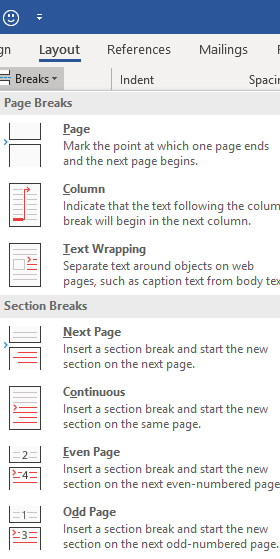One of the key foundation concepts that separates the genuine Word guru from the wanna-bee is the judicious use of section breaks in your longer, more elaborate documents. Taken together with the use of styles, as discussed here, they create a very useful platform in the design and structure of your Word document that makes many other features possible or at least much easier.
Your longer Word documents are bound to contain clear subdivisions. An obvious example would be chapters in a report or manual (or even novel, should your ambition lead you in that direction). If you separate your document’s chapters with a section break, it gives you the power to treat individual chapters effectively as individual mini-documents within the whole document. Which means that your chapters could have attributes that, without section breaks, can only be applied to entire documents.
For example, individual sections can have their own unique vertical alignment, margin measurements, page numbering and headers and footers among many other features. In this way, having separate sections in your document gives you the ability to effectively ‘mix and match’ different layouts and page formats within the same document. If necessary, each section can function as a separate entity on its own within the document, so you could modify (add to, or delete from) the content of one of your chapters without having any effect on the content or pagination of any other chapter.
To insert a section break, you need only position your cursor at the required location, such as the intended beginning of a chapter. Find the Breaks menu on the Layout tab, and you will see a selection of different breaks, the first of which is the ordinary manual page break. It should be stressed that this is entirely separate and distinct from the section break; you can, and very likely will, have many separate pages within the self-same section. The manual page break simply determines where a new page begins; it does not begin a new section.

There are a number of different breaks you can easily insert via this menu, with the exception of lunch or coffee breaks. (Oh stop it, you wacky funster – Ed.) If you are seeking to separate chapters, the most relevant option would normally be the Next Page section break, the first choice in the lower part of the menu which means that your new chapter would begin at the beginning of a new page.
If you do divide your document into self-contained sections, you may find it useful to add the section indicator to the status bar at the foot of the Word screen; otherwise, you may not be able to easily tell which section you are currently located in a long document.
Simply right-click anywhere in the status bar and select Sections from the ensuing menu to turn on the section indicator; Word does not display this indicator by default. By keeping one eye on this indicator as you move around your document, you will always know precisely what section, as well as what page, you are on.
Look out for future posts which will delve more deeply into the use of section breaks in conjunction with headers and footers.
